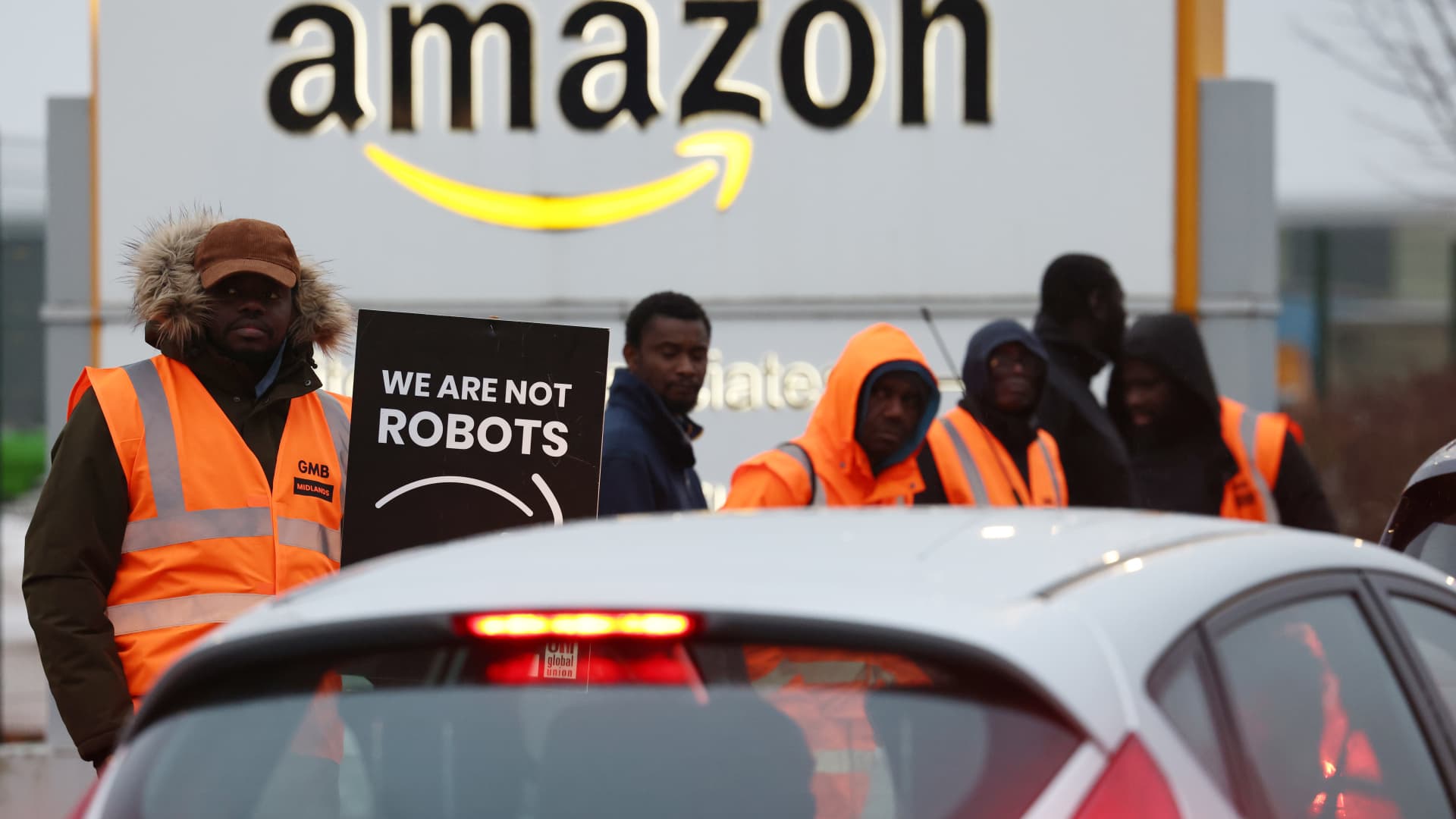An Amazon worker on the picket line during a strike over pay at the Amazon.com Inc. fulfilment center in Coventry, U.K., on Feb. 28, 2023.
Bloomberg | Bloomberg | Getty Images
Artificial intelligence has emerged as a key tool for companies to drive growth — and reduce labor costs —particularly as pressure mounts for businesses to remain competitive.
Companies in industries ranging from cloud software to fast food to e-commerce have internally deployed AI tools to to improve productivity, customer experience and supply chains. AI is also leading to less reliance on human labor in some spaces, particularly entry level jobs and positions tied to automation and manual tasks.
Unemployment has risen this year specifically among young tech workers whose skills overlap with AI models, according to Goldman Sachs chief U.S. economist Jan Hatzius.
“Although aggregate labor market impacts from generative AI remain limited, we are starting to see evidence of labor demand hits in the most AI-exposed industries,” Hatzius wrote in a July 25 note to clients. “Employment growth has turned negative in marketing consulting, call centers, graphic design, web search and software development, and the tech sector’s employment share has declined below its long-run trend.”
To be sure, it’s hard to quantify the exact effect AI is having on labor at this stage of the tech cycle. One way to understand the trend is by assessing commentary made by the top executives at big employers and high-growth firms.
CNBC compiled commentary from management at companies ranging from McDonald’s to Amazon to Palo Alto Networks, on how internally deployed AI tools and agents are being used to improve productivity, customer experience, supply chains and potentially headcount.
The remarks show major tech and software companies are using AI to cut away at labor needs and improve productivity.
Microsoft, for one, said it is saving hundreds of millions of dollars a year just by leveraging AI for support functions. It added that “you don’t need human interaction” to make those roles more productive. PayPal’s “PayPal Assistant” customer service bot is already cutting down phone calls and active events, the company’s CEO said earlier this year.
According to Deutsche Bank analyst Brad Zelnick, the main AI use cases from software companies seem to be on developer productivity, customer service and support, as well as seller efficiency — which refers to how a company’s sales revenue compares to the resources they used. Software firms are also increasingly citing the use of AI across functions such as finance and human relations, he added.
“While some teams have been more explicit about labor savings (~50% of companies that have discussed internal AI use have mentioned headcount rationalization), many have noted meaningful improvement in efficiency which over time should drive labor savings or at least hiring at a slower rate,” Zelnick said in an Aug. 6 note to clients. He highlighted Palo Alto Networks, CrowdStrike, Shopify, Intuit and Microsoft as some standout names that are leveraging AI in ways he said “should support an ability to improve incremental margins.”
“If software companies are cutting/slowing headcount, we imagine it will be similar across industries and seat-based models will continue to be questioned even if they are able to price for the value they are creating near term,” Zelnick added.
Amazon’s newest robot, Vulcan, gets ready to stow a bag of Skittles in an Amazon warehouse in Spokane, Washington, on April 17, 2025.
Katie Tarasov
Robotics continues to be a focus for shipping and e-commerce companies that are looking to cut labor costs.
UPS’ chief executive said during the company’s second-quarter earnings call in May that greater use of automation and robotics will lead the company “to become less reliant on labor.” Amazon CEO Andy Jassy said in July that the company uses more than 1 million robots across its facilities, which he said are “improving cost efficiencies” and giving customers faster delivery times and lower costs.
To be sure, companies are opting for cautious messaging around AI and its labor implications.
Starbucks is using AI in its order and supply chain management processes — such as with its “Green Dot Assist” platform made with Microsoft Azure’s OpenAI — but has so far framed the technology as being a supplement to its baristas. Amazon’s Jassy executive has said robots are lessening the number of physically demanding tasks for its team members, making operations safer.
A longer-term hiring cycle in ‘high-impact areas’
This year has been tough for job seekers, with the market marred by hiring freezes, broader economic concerns and an entry-level hiring squeeze. But in the long run, some on the Street say that AI will cultivate more employment opportunities rather than lead to widespread layoffs.
“We remain skeptical that AI will lead to large employment reductions over the next decade, primarily because AI-related innovation will create new work opportunities that help offset job losses from automation,” Goldman’s Hatzius said.
Job cuts across major tech giants seen since last year moreso underscore a correction since their hiring spree during the Covid-19 pandemic, according to Jefferies analyst Brent Thill.
Job growth across software and internet companies has been strong in 2025, albeit below peak levels in 2021 and early 2022, Jefferies noted. Only 23% of tech companies in the firm’s coverage has announced layoffs this year, down from 37% in 2024.
“Overall, we view the current layoff cadence as a sign that the industry is nearing the end of its post-COVID workforce re-calibration,” Thill said in a July note to clients. “AI is driving efficiency while also fueling a new hiring cycle. While AI continues to drive efficiencies and reshape workforce needs, particularly in automating lower-skilled roles, we are also seeing selective hiring in high-impact areas.”





